MAJOR FESTIVALS AND EVENTS
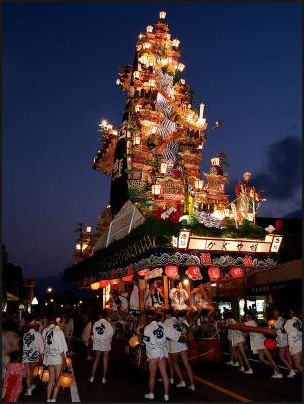
Every town, city and village either has a unique festival or a unique version of a national festival. The ones included here are the most well known ones.
Many Japanese festivals are called "matsuri. “Matsuri”, a Japanese word that means “to entertain” and “to attend to,” is used to describe both festivals and worship at Shinto shrines. It also implies respect duty, and willingness to listen to and serve “kami” (“spirits or gods”) and brings their power to everyday life. Most matsuri give honor and thanks to the kami associated with the shrines used in the festivals.
Matsuri are usually religious occasions that allow parishioners of a local shrine to commune with the god of that shrine and wish for a plentiful harvest. They usually feature purification rites, offerings, sharing of food, rituals carried out by priests and a procession of “mikoshi” — portable shrines carried by parishioners of the shrine — and decorated floats whose aim is to bring the attention of the gods to the needs of the people.
Japan has 14 national holidays, more than most countries, and these are welcome relief for salarymen who work on Saturdays and have trouble using their vacation leave. The passage of the "Happy Monday" law in 1998, placed most of the nations holidays on Monday. Book: “Great Festivals of Japan” by Hiroyuki Ozawa (Kodansha International, 2000). Websites: JNTO Calendar of Events JNTO Calendar of Events ; JNTO Festivals List JNTO Festivals List ; Japan Visitor Japan Visitor
Tourist Office: Tourist Office, Japan, tel. 81- , fax: Websites: Map: Japan National Tourism Organization JNTO Hotel Web Site: Japan Hotel Web Sites: JapanHotel.net JapanHotel.net Ryokan and Minshuku Japanese Guesthouses Japanese Guesthouses Budget Accommodation: Japan Youth Hostels (click hostels for good map and description of hostels) Japan Youth Hostels Check Lonely Planet books; Getting There: is accessible by air and by bus and by train from Tokyo (six hours) and Osaka (12 hours) and other Japanese cities. Lonely Planet Lonely Planet
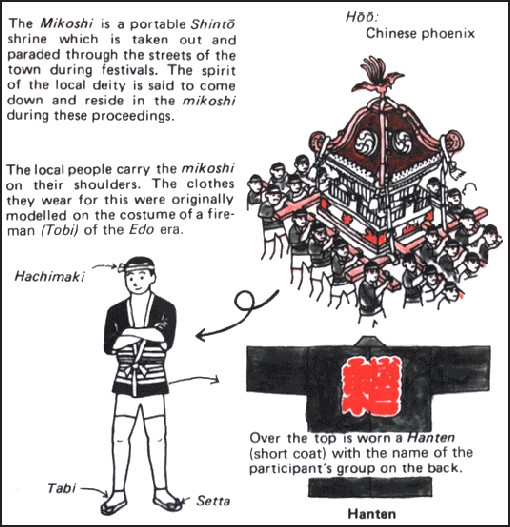
features of mikoshi matsuri
JANUARY
January 1st — “New Years Day” is arguably the important holiday in Japan. People flock to shrines and usher in the new year with prayer (See People, Holidays and Festivals). On New Years Eve the people of the Oga Peninsula in the Akita Prefecture engage in the unique Namahage Festival, in which young men dressed as demons go from door to door frightening children into behaving themselves.
In Kyoto, Yasakajinja shrine features a rite called “okera mairi” in which people throw little bits of rope into a ceremonial fire and collect embers which are used to light candles at home which are cusped to ensure good health. At the shrine people play a “karuta” , a game in which participants dressed on Heian period costume slap cards with poetic verses on them. At Shimogamojinja shrine men kick around ball in a game called “kemari” . During the Shigyoshiki New Year ceremony geiko and maiko appear wearing hair ornaments made of rice plants and formal black kimonos with patterns at the bottom.
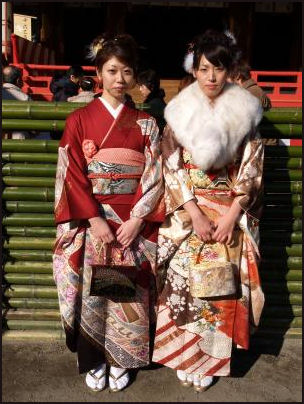
Coming of Age DayRinging the massive bell at Chionin Temple in Kyoto is an important New Year’s event. It takes 17 monks to ring the bell, 16 of them to raise the giant wooden hammer, which they do by pulling on the ropes, swinging the hammer away from the bell, while the 17th monk hangs from the striking end, ready to push off with his legs in the split second before impact. The chime produced by the bell lasts for 20 minutes. The event is often shown on New Year’s television broadcasts.
Early January — “Coming-of-Age Day” is a Japanese holiday in which thousands of 20-year-olds gather at temples to participate in a ceremony that symbolizes reaching adulthood and leaving their childhood behind. Marking the age when young people are allowed to drink, smoke and vote, the ceremony dates back at least to the 7th century. Young women dress up in colorful kimonos and some young men wear traditional “hakamas” , long pleated skirts, and listen to speeches by local leaders and politicians.
Early January — “New Year’s Sumo Tournament” in Tokyo.
January 6th — “Dezomeshiki” is celebrated in Tokyo with firemen perform a number of dazzling acrobatic tricks on top of tradition bamboo fire fighting ladders as part of the New Year's Parade of Fireman. Acrobatic firemen do headstands, hang upside down, do swimming strokes, walk up and down their fire ladders as if they were walking on wall and perform other stunts. About 2,600 firefighters take part in the celebration. Helicopters and 150 fire trucks are mobilized for disaster prevention drills.
January 9th to 11th — “Toka Ebisu” is a festival at Inamiya Ebisu Shrine in Osaka that sometimes attracts more than a million people who try to get their hands on auspicious token hung from bamboo branches.
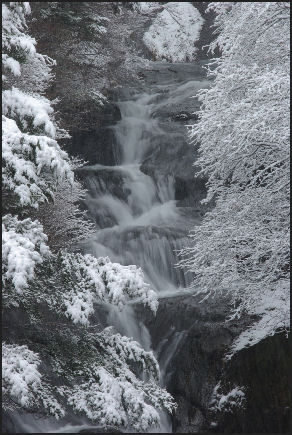
winter scene January 14th — “Doya Doya” is a festival at Shitenno-ji Temple in Osaka in which young men in loin clothes and headbands try to get a hold of a talisman said to bring good harvests to farmers.
January 15th — “Muko Nage” is a curious ritual in Matsunoyama, Niigata Prefecture, in which men who were married the previous year are tossed into the snow by their in laws.
January — “Sandera Maairi” in Hida, Gifu Prefecture features kimono-clad women lighting candles on a bank of the Setogawa River. The festival honors Shinran, the founder of the Jodoshinshu sect of Buddhism, who died on January 16, 1282. Dozens of snow pillars topped with candles are placed along the town’s main streets. The festival is popular with couples because in the old days the river is where young women went to meet their lovers.
January — “Harasu Masuri “ in Owase in Mie Prefecture is a kind of memorial for whales that have been killed that features men rowing traditional whaling harpoons boat decked out with colorful flags. Fishermen in colorful costumes worship ay Asukajinja shrine. The event climaxes with one participant throwing a harpoon into the sea.
FEBRUARY
Early February — “Onda Matsuri” in Asukamura Nara is a rice-planting festival that climaxes with sexually-explicit skit that has drawn large crowds in recent years. The event starts when two men — one dressed as a long-nosed Tengu goblin and the other as an old man — enter. They prance around to the rhythm of drum beats, lead a man dressed as ac ow through a field, and perform rituals meant to enrich local rice paddies. When they return Tengu makes love to his new bride Otafuku ( a role played by a man) following instructions provided by the old man. The display is quite convincing. At one point the Tengu wipes papers on his wife’s thighs and throws them into the crowd. People try hard to grab the paper which is supposed to bring about the birth of healthy kids. The festival used to obscure and lightly attended but Internet chatter about the sex has brought large crowds.
Early February — “Festival” at Kokusekiji Temple in Oshu. Iwate Prefecture features 110 loincloth-clad men taking a bath in frigid river near the temple and climaxes with men scrambling for a hemp sack thrown into the crowd. The festival drew some attention in 2008 when Japan’s railway company refused to display a poster of the festival, saying it would cause offense.
Early February — “Otomotsuri Festival” at Kamuikura Shrine affiliated with Kumano Hayatama Taisha shrine in Shingu, Wakayama, features about 2,000 men in white robes running down 538 stone steps with torches, sending flames leaping and sparks flying. The festival was first held 1,400 years ago and is closed to women.
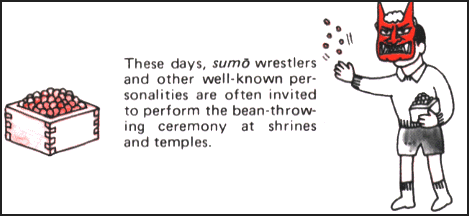
Setsuban
February 3rd or 4th — “Sentubun” is a festival held all over Japan that marks the beginning of spring on the traditional calendar. Also known as the bean throwing festival, it is celebrated by people throwing “mame-maki” packets of sacred soybeans into the air and around their homes to cast out evil spirits. In a ceremony called “hari-kuyo” broken sewing needles are given a final resting place in tofu-filled pans placed on a Shinto altars. In Kyoto at Yoshidajinja shrine, people dressed as demons in yellow, red and blue costumes prance around the shrine’s stage to disperse a four-eyed creature called a “horoshi” .
February 3rd or 4th — “Lantern Festival” at Kasuga Taisha Shrine in Nara features the lighting of 3000 stone lanterns and hanging bronze lanterns at the shrine, producing a wonderful glowing atmosphere among the shrine’s vermillion buildings. The event is held on the last day of winter on the Japanese calendar and ushers in spring. Visitors to the shrine enjoy theatrical performances and pray for good health and fortune for their households.
February — “Yokote Snow Festival” in Yokote in Akita is famous for its “kamakura “ snow huts. They typically stand three meters tall and have a diameter of 3.5 meters.
February 11th — “Commemoration of the Founding of Japan” marks the ascension of the legendary emperor Jimmu to the throne in the 7th century B.C. It was an important day in State Shintoism and was a day when military parades were held. Now is an important day for ultra-nationalists.
February 14th — “Valentine's Day” is celebrated in Japan with females giving chocolates to males.
February 15th — “Grass Fire Ceremony” at Nara Park in Nara features entire hills go up in a blaze of glory with Nara's famous temples in the foreground. This spectacle has a practical origin. It began centuries ago as way to exterminate rats and prepare the soil for planting.
February 16th-17th — “Bonten Festivals” are in several towns in the far northern prefecture of Akita. The largest one is held in the town of Yokote where 10 foot tall wooden poles draped with colored streamers are paraded through the streets.
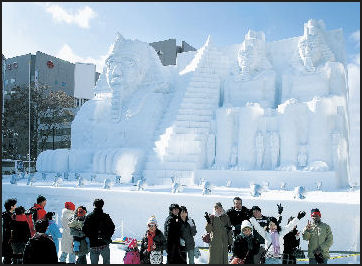
Sapporo Snow Festival February 2nd — “Snow Festival” is a festival in Sapporo famous for its ice sculptures. Truckloads of snow are brought in for the festival. Then with the help of wooden frames the snow is shaped into blocks of ice and finally sculpted into shapes of demons, famous landmarks or whatever captures the sculptures fancy. The sculptures are best viewed at night when they are all lit up with colored lights.
Typically more than 300 snow and ice sculptures are created by volunteers and over 2 million visitors check them out. There are sculptures of well known international landmarks, famous paintings and sculptures, popular animation characters and people who dear to the hearts of Japanese such as baseball player Hideki Matsui. The 57th Sapporo Snow Festival in 2006 featured 338 snow and ice statutes, a 100-meter slide and 1,000-square-meter maze at three sites. Sometimes there are rows and rows of snowmen
3rd Week of February — “Kamakura Matsuri” is a festival held in Yokote and other towns in the Akita region that features small snow huts constructed around towns homes and down its side streets.
3rd Saturday of February — “Eyo Matsuri” (Naked Festival) at Kannonin Temple in Saidaiji in Okayama features hundreds of nearly naked men in loin clothes, fighting, scrambling, pushing and shoving one another to try to retrieve a pair of “shingi” (lucky wooden sticks) that are tossed to them in the courtyard of the temple at midnight by temple priests.
The festival has been held since 1504 and is believed to have its origins in the Nara Period (710-784). Despite the cold temperatures thousands of loinclothed men splash in the temples freezing purification pool before attempting to catch the sticks. Whoever touches the sticks, it is said, gets good luck for the coming year and can be sold for cash. While the men scramble for the sticks women egg them on by beating drums. In 2003 a crowd of 9,000 men showed up and two men were trampled and still unconscious several days later.
Late February and Early March — “Japan Grand Prix International Orchid Festival” at the Tokyo Dome features 80,000 orchids from 24 countries. The 3,000 species on display represent 10 percent of the world’s orchid species. Tickets cost about ¥2,000 at the door. The events draws large crowds. There are competitions for the best orchid in several different classes, an “Orchid Fantasy of Light” show, lectures and instructions on growing orchids and over 150 tables and booths with orchids and orchid-growing gear for sale. In 2008, there were over 100,000 orchids from 21 countries on display.
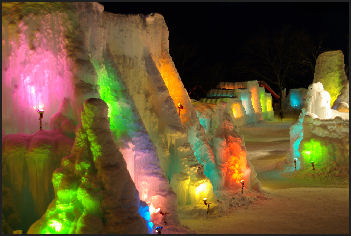
Lake Shotku Snow Festival Late February and Early March — “Plum Blossom Viewing Season” precedes the cherry blossom season. Yoshini Baigo (an hour from Tokyo) is a village on the banks of the Tama River with over 25,000 plum trees. Good places to see plums blossom in Kyoto include the Kitano Tenmangu Shrine. Good places to see plums blossom in Osaka include Expo Park, Kinyuji Temple and Dohmyoji-tenmangu Shrine
Late February or Early March — “Tokyo Marathon” draws over 30,000 runners and is usually won by an African, with good showings by Japanese runners. Over 32,000 people ran the Tokyo marathon in 2008.
MARCH
March — “Tokyo International Arts Festiva” l has theater, opera and dance events at various places around the city.
March 1st — “Omuru Mountain Burning Ritual” is a spectacular sight as many acres of mountainside near Omuro go up in flames and smoke
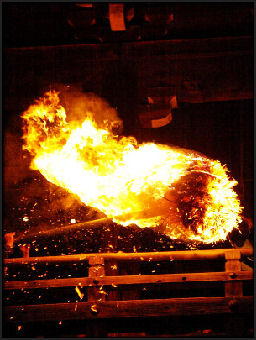
March 1st-14th — “Omizu-tori” (Water Drawing Festival) at Todaiji Temple in Nara features monks running around the balcony of the Nigatsudo Hall with flaming six-meter-long, 40-kilogram torches made of bamboo and cedar needles. The monks thrust the torches outward from the balcony, showering the crowd below with sparks and embers. The sparks and embers that fall on the festival goers is said to purify them. The ritual takes place every night from 7:00pm to 8:00pm and the sparks that fly on March 12th are particularly auspicious.
The ceremony marks the beginning of spring. At the sound of a bell the torch-carrying monks appear one after another at regular intervals. They ascend 80 steps on the left side of the hall and run across the balcony thrusting the torches into the air and spinning them to send the sparks flying. The crowd cheers whenever one of the torches does something unusual. On March 12th, 11 priests carry 11 exceptionally large torches. On March 13, under torchlight, the monks carry sacred water from a well below Nigatsudo and offer it to those present. The water is believed to slow the process of aging.
The festival is said to have been initiated in 752, the year the Great Buddha in Nara was completed, by a priest named Jitchu to bring good weather, health and peace and to ask forgiveness for various errors. During the festival monks participate in a variety of spiritual exercises, such as blowing conch shells, chanting sutras and ringing temple bells. Nigatsudo means February Hall, a name thought to have been derived from ceremony. More than 33,000 people watched the 1,257th ceremony in 2008.
March — “Hiburi Shinji “ is a ritual held Aso Shrine in Aso Kumamoto Prefecture in which participants swing around two-meter-long ropes with burning torches attached to their ends. According to legend the ritual began as welcoming rite for the bride of one of the shrine’s kami.
March 3rd — “Hinamatsuri” , or Girl's Day, is celebrated by families with girls who set up shelves in their homes with “hina” dolls a girl has received as presents arranged in a hierarchy. The dolls represent the ancient imperial court with the emperor and empress occupying the highest position on the shelf, three ladies in waiting on second shelf, and five court musicians on the third shelf. Ministers sit on either side of trays of food on the fourth step, and the fifth row features guards flanked by an orange tree and a cherry tree. Families also celebrate by drinking a special kind of sweetened sake, eating food symbolizing purity, praying for their girls' happiness.
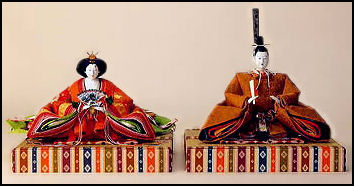
Hinamatsuri dolls The practice of displaying dolls like this began in the Edo Period and started as a way of warding off evil spirits. The festival has its origins a Chinese purification rite in which evil spirits are transferred to dolls that are cast adrift on a river. These days the hina dolls are very expensive and not meant to be caste away or played with. A girl traditionally receives the first dolls from her parents and grandparents at birth and on her first birthday. According to legend, if a mother does not pack away her dolls soon after the holiday her daughter will have trouble finding a husband.
March 3rd — “Urasa Hadaka Oshiai Festival” in Yamato, Niigata Prefecture is one of Japan's most famous naked festivals. Scores of near-naked young men compete to reach a Buddha statue in Bishamondo Temple hall. They also run around carrying massive 75 pound rolled up scrolls.
Mid March — “Saito Festival” in Kashimajingu Shrine in Kashima, Ibaraki Prefectures features costumed people with oak sticks doing a maypole-like dance to drumbeats and songs.
March 13th — “Kasuga Matsuri” at the Kasuga Shrine in Nara features 1000-year-old classic dances.
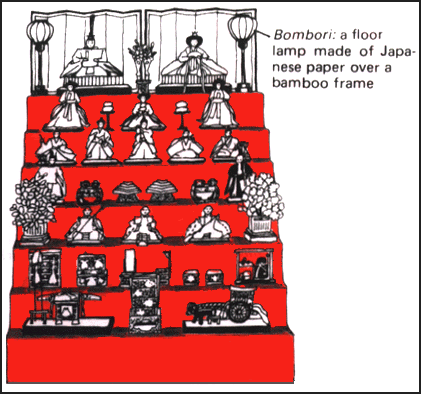
Hinamtsuri doll display March 14th — “White Day” is a kind a reverse Valentine's Day. It is celebrated with males giving white chocolates to females.
Mid-March — “Sagicho-sai Festiva” l at Himure Hachiman Shrine in Omi-Hachiman in Shiga Prefecture features floats decorated with food and grain carried by men dressed as women.
Mid-March — “Second Sumo Tournament” in Osaka.
March 22nd — “Spring Equinox” is a national holiday. It is often celebrated with visits to ancestral graves to pay respects to deceased relatives. In some places such as Mt. Aso in Kumamoto large bonfires are lit from used cooking oil to make the Chinese characters for “fire” and “flame.”
Late March — “Tokyo International Anime Fair” is held at the Tokyo Big Sight convention center in Odiaba and Ariake, Tokyo. Describing the event Virginia Hefferman wrote in the New York Times: “The Death-Star-sized convention center that housed the fair — with its sprawling trade show, closed-door industry symposiums and awards ceremony — were decked with images of exuberant, candy-colored anime figures. As they gazed down on the hundred thousand or so fans who ambled among the booths, their googly baby eyes, seemed to monitor the proceedings.”
APRIL
April — “Baei Keiba Sled Race” in Asahikawa is a horse race that features muscular farm horses pulling 500 kilograms over 200 meter straight courses. About 60 horses qualify for the main event. Sometimes over 200 try out. Many of those that fail to make the main race end up as food.
Early April — “Kanamara Fertility Festival” in Kawasaki near Tokyo features people parading around with phallic symbols of all sizes, many with prayers on them.
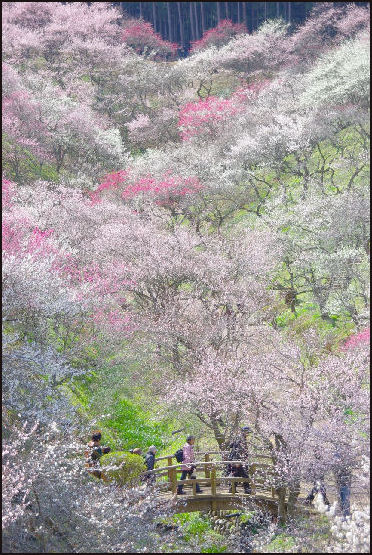
Cherry trees in Yoshino near Osaka Early April — “Cherry Blossom Viewing Season” is a major event throughout Japan. Good places to see cherry blossoms in the Tokyo area include Ueno Park, Sumida Park (Asakura Station), Yakushina Shrine, Chidorigafuchi by the moat at the Imperial Palace, Showa Memorial Park (Nishi-Tachikawa Station), Aoyama Cemetery (Nogizaka Station) and Shinjuki Gyeon.
Good places to see cherry blossoms in the Osaka-Nara area include Osaka Castle Park, Expo Park, Settsukyo Park, Nara Park, Hase temple, and Yoshino (an hour from Osaka), Good places to see cherry blossoms in Kyoto include the Path of Philosophy, Uji Park, Maruyama-koen Park, Arashimiya and the Imperial Palace park.
Early April — “Ose Festival” at Ose Shrine in Numuzau, Shizuoka Prefecture features fishermen dressed in women’s clothing dancing on fishing boats to ensure safe trips to sea and good catches. The custom is said to have originated when the wife of a fisherman gave her husband a kimono to ensure he was safe.
April 1st-30th — “Miyako Odori” or the Cherry Dance is held at the Gion Kaburenjo Theater in Kyoto.
April 8th — “Buddha's Birthday” or “Hana Matsuri” is celebrated at all Buddhist temples in Japan by devotees placing flowers in the temples and sometimes pouring tea on Buddha's head.
April 11th — “Nagashi-bina Festival” is held along the Sendaigawa River in Michigase in Tottori. Prefecture. It features dolls being sent down the river on small platters to wash away bad luck and get rid of evil spirits.
April 14th and 15th — “Sanno Matsuri” is a festival at Hie Jinja Shrine in Takayama that features gorgeous floats carried on the shoulders of floatbearers. Symbolizing the wish of farmers for a good harvest, the first day of the festival begins when the floats are taken from the storehouses and prepared for the procession. After a Shinto ceremony at Hie Jinja Shrine, the wooden floats, some hundreds of year old, are paraded through the streets. In the evening the procession continues with floats adorned with lanterns. Many people dress in Edo period costumes. On the second day. marionettes shows ate performed on three of the 12 floats.
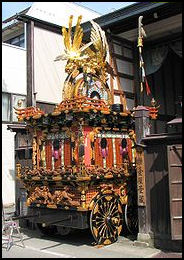
Sanno Matsuri float April 16th-17th — “Yayoi Matsuri” is a festival is held at the Futarasan Temple in Nikko.
April 19 — “Okoshi Daiko” in Furukawa in Gifu prefecture is a rowdy night time festival in which a large drum is pulled through narrow streets and teams half-naked drunk men try to out muscle their rivals and attach their herald drums to the large drum.
April 29th — “Greenery Day” is celebrated throughout the nation. Intended to be a kind or arbor day for tree planting, it is held on a day used for celebrating Emperor Hirohito's birthday before World War II.
Late April, Early May”Spring Festival” at the Meiji Shrine in Yoyogi Park in Tokyo features traditional dance, theater and music performances and an archery competition with contestants in traditional kimonos.
Late April or Early May — “Mikurumayama Festival” in Takaoka, Toyama Prefecture features floast elaborately decorated with laquer and metal fittings.
April 29 to May 5th — “Golden Week” is one of the biggest holidays of the year. Many people take a week off from work and go on family vacations or overseas trips.
MAY
May — “Iris Flower Season” is a highlight of late spring. Good places to see blooming irises in the Tokyo area include the Imperial Palace, Meiji Shrine and Shinjuku Gyeon Park. Good places to see blooming irises in Kyoto include Heian Shrine.
May — “Bonsai Festival” at Bonsai Village in Saitama draws around 70,000 people.
May 3rd-5th — “Odakoage” is a kite fighting festival in Hamamatsu that features huge garage-door size kites that are hoisted into the air by teams of 20 or so men. Each member of the team has a unique responsibility and the team is led by a captain, an honored position. Neighborhoods sponsor the kite teams, and usually there is one kite for each first born son that is born in that neighborhood that year.
On the night before the competition there is much drunken merry making in the streets as the kite teams carry decorated floats on their shoulders in a colorful procession. Each float carries a musician that plays to the crowds. On the day of the competition, the kites are raised in the air and matched against other kites in fights in which kites get entangled in each other’s strings. The lines of the kites are coated with glass and the idea is the severe the chords on the other kites and bring them crashing to the ground. The winner is the team whose kite stays aloft he longest.
May 3rd-4th — “Hakata Dontaku Festival” in Fukuoka is one of the biggest Golden Week events, with more than 2 million showing up some years. It is celebrated with men, women and young people in fancy costumes parading through 1.3-kilometer stretch of road, escorting other men and women masquerading as legendary gods on horseback to the accompaniment of samisen and drums. There are also baton twirlers and brass bands. About 20,000 people in 200 groups participate in the parade.
May 4th-6th — “Yabusame” features 15th century style mounted archery at Sengen Shrine in Fujinomiya, Shizuoka Prefecture.
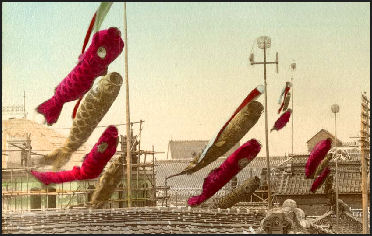
flying carp in the 19th century May 5th — “Children's Day” is celebrated throughout the nation with families displaying samurai dolls and eating special rice cakes, and flying “Koinobori” carp-shaped paper streamers that attract strength, health and prosperity for children, particularly boys. Most of the activities are geared for boys because the holiday grew out of the holiday of Boy's Day (Girl's Day is on March 3rd).
The bigger the carp streamer, the older the son. Carps are a popular Japanese symbol. They are admired for their strength and determination to swim upstream, traits that parents want their children to have. These days many Japanese live in apartments as thus the carp streamers have shrunk in size to accommodate being put in small spaces.
Early May — “Yabusame Umashinji” in Kyoto at Shimogamo Shrine is an annual horse and archery event.
May — “Fushiki Hikiyama Festival” in Takaoka in Toyama Prefecture is popular festival that has been held at Fushiki Shrine since the Edo period. Also known as the “kenkayama” (“fighting floats”), festival, it features a procession of floats hung with up to 360 beach-ball-size lanterns. The floats are carried on wooden carts with huge wooden wheels and weigh 10 tons and are eight meters high. Spectators cheer whenever the floats collide.
May — “Manbu Oneri” at Dainenbutsi Temple in Hirano Ward, Osaka has been held since the Edo period. A man with golden mask, dressed as a Buddhist saint, walks around the main hall while monks chant 10,000 sutras in an effort to get the saint to come back to world of the living and lead the spirits of the dead to the “Land of Happiness.”
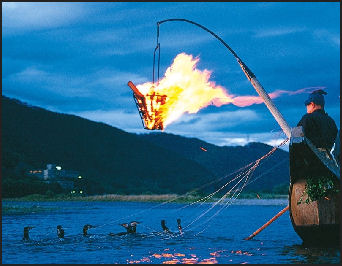
Cormorant Fishing May — “Kakeuma Shinji” at Fujinomori Shrine Fusimi Ward in Kyoto is an annual horse event with riders performing a number of tricks derived from battlefield techniques. Some riders hang on to the necks of their horses as they gallop through a shower of imaginary arrows of outrageous fortune. Others leave behind a trail of paper streamers as they demonstrate the arrow swatting technique. One of the most difficult moves is when the riders ride on the side of the horse to protect themselves from an imaginary enemy. Most of the moves require the rider to slide of the saddle so extra attention is given to the saddle to make sure it doesn’t slip.
May 11-October 15th — “Cormorant Fishing” is carried out on the Nagari River near Gifu. The cormorants have ropes tied around their legs and are used by fisherman to catch small fish in the river. It is only done at night and lanterns are used to attract the fish.
May 15th — “Aoi Matsuri” in Kyoto has been called the world's oldest festival. Held at the Kamigamojinja and Shimogamojinja shrines, it features a procession with 600 or so men, women and children dressed in costumes like those worn by nobles and members of the Imperial court in the Heian Period (794-1185) The men wear white or grey tunics with wedge shaped black hats and women wear bright orange kimonos.
Also featured in the procession are huge decorated carts pulled by oxen with orange-colored yokes and costumed riders on horseback that shoot arrows at three targets 100 meters apart while riding at a full gallop. The festival gets its name from the “aoi” or hollyhock leaves carried by the participants.
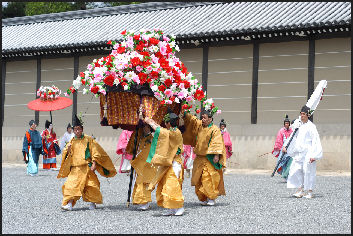
Aoi procession The festival dates back to a time when Kyoto was often ravaged by floods and local people asked the gods for help. When relief appeared the people showed their thanks by throwing a festival. The central act of the festival is the offering of “aoi” leaves as a sign of respect to gods of Kamigamo and Shimogama shrines.
Mid May in Odd Numbered Years — “Kanda Festival” at Kanda Myojin Shrine in Tokyo features a parade with 200 portable shrines and people dressed in replicas of 9th and 11th century costumes.
Mid-May — “Third Sumo Tournament” in Tokyo.
Mid May — “Nara Takigi Noh” at Kofuku-ji and Kanga Taisha Shrine in Nara features traditional noh theater performances lit by burning torches.
May 17th and 18th — “Spring Festival” at the Toshuga Shrine in Nikko features a parade of 1,200 people in elaborate samurai costumes.
May 19th — “Fan Throwing Festival” at the Toshodaiji Temple in Nara.
3rd Weekend in May — “Sanja Matsuri” is one of Tokyo's three great festivals. Held near the Asakusa Kannon Temple it features processions of over 100 Omikoshi, portable shrines. The three-day festival climaxes on the final day with around 10,000 men dressed in happis chanting “Soiya! Soiya!” around the three Honja mikoshi said to carry three festival gods enshrined in Asakusa Shrine. The festival attracted 1.5 million people in 2007. That year there was a problem with people climbing the shrines, which is regarded as sacrilegious, and the event was curtailed.
3rd Sunday of May — “Mifune Matsuri” is a festival held in Kyoto that features a parade of ancient boats.
May Every Six Years — “Onbashira” is a festival that takes place over a month and features the spectacular log-riding ritual at Suwa Taishi Shrine in Suwa, near Nagano. Symbolizing the collection of pillars to build a shrine, the festival has five parts: 1) transporting the logs 12 kilometers from a mountain slope; 2) riding the logs down the hillside; 3) parading the logs through the streets; 4) transporting them across the Miyagawa River; and 5) erecting the pillars inside the three shrine compound . The last festival was held in 2004.
The log riding event is known as “Kiotoshi” . The logs come from fir trees and are quite large. They average 17 meters in length and weigh around 11 tons. Riding them down the steep hill is quite dangerous not only for the people riding on the logs but also for the “minders” who try to guide them and the thousands of spectators that gather on the hill to watch. People have been seriously injured, even killed in the event.
Eight logs in all are decorated and dragged with thick straw ropes and let loose on the slope. Records of the festival go back to the 8th century and no one is sure of its origin or original purpose People drink a lot of sake and chant and blow trumpets when the logs come down. During the river crossing stage, men wearing only loincloths pulls the logs with ropes from one side to the other. The ritual is purifies the logs. Website: Onbashira
JUNE
June — “Hydrangea Flower Season” is during the rainy season. Good places to see blooming hydrangea irises include Sanzen-in Temple and Fujinomori in Kyoto; Shimoda Park, Kakusan Jinja Shrine and Asukayama Park in Tokyo.
June — “Rice Planting Festivals” are held throughout Japan, particularly in the Kansai region, throughout the month. Most of them commemorate the time that rice seedlings are transplanted into fields.
Early June — “Kyoto Takigi Noh” at Heian Shrine in Kyoto features traditional noh theater performances lit by burning torches.
Early June — “Minu no Hanadaue” at Mibujinja shrine in Chiyoda in Hiroshima, Prefecture features women in traditional work costumes planting rice and singing to the accompaniment of drumming by drummers who are also wading through the rice fields. Some of the songs are filled with sexual innuendos. Cattle are colorfully decorated and paraded through the paddies.
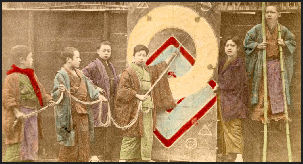
19th century kite festival Early June — “Shirone Takogassen” is a huge kite fighting festival that last for five days and is held along the Nakanokuchi river bank in Shirone, Niigata Prefecture. Over 300 years old, it is said to be the world’s largest kite fight. About 300 kites take part. They are made from bamboo and washi paper and can be as large as 23-x-17 feet and weigh as much as 50 kilograms. Each kite has a unique design that has in some cases remained unchanged for three centuries. Tsugaru kites are often decorated with well-known historical figures. Many have ukiyoe-style pictures. The rope is made at great expense from hemp.
Teams from Shirane compete against teams from nearby Akikatamaru village. In a typical fight one kite from Shirone is raised on one side of the river and a second kite from Akikatamaru is raised on the other side of the river. Teams of 30 to 50 men run along the river bank, pulling the kites towards one another. The teams the severe the other’s line — usually in just a few minutes — is the winner. Seven matches are held with seven groups from each town. The number of battles won and the amount of time the kites stay aloft determines the overall winner.
Describing one fight Tatsuya Sakamoto wrote in the Daily Yomiuri: “Giant Kites waged a dynamic air battle...Their lines became entangled with one another high above the 80-meter-wide stream before plunging into the water. Participants then yanked on the 130-meter-long lines with all their might in what quickly became a giant tug of war.”
June 6th — “Heso Matsuri” in Matsumoto is also known as the “Naval Festival.” A crazy celebration that honors Matsumoto's distinction of being the 'naval of Japan' because of its location in the center of the country, it features people dressed up in huge hats and costumes that cover every part of their body except their navels. These groups dance and party in the streets.
June 14th — “Rice Planting Festival” at the Sumiyoshi Shrine in Osaka features the ceremonial transplanting of rice seedlings by young girls in traditional costumes.
June 15th — “Chagu Umako Horse Festival” features a parade of colorfully-dressed horses through the city to the Hatchiman Shrine in Morioka, Toshuku prefecture.
Mid June — “Kanazawa Hyakumangoku Festival” features a procession with people dressed in samurai and period costumes. The are also firemen doing acrobatic maneuvers on ladders, torch light Noh performances and fireworks.
June 10th-16th — “Sanno Matsuri” is another one of Tokyo's three great festivals. Held near the Hie Shrine it features a procession of portable shrine through the busy streets of the Akasaka district.
Image Sources: 1) 3) 7) Ray Kinnane 2) 4) 5) 6) 7) 9) 10) 13) 14) JNTO 8) Association for the Promotion of Traditional Crafts Industries 10) 11) Wikipedia 12) 15) Visualizing Culture, MIT Education
Text Sources: New York Times, Washington Post, Los Angeles Times, Daily Yomiuri, Times of London, Japan National Tourist Organization (JNTO), National Geographic, The New Yorker, Time, Newsweek, Reuters, AP, Lonely Planet Guides, Compton’s Encyclopedia and various books and other publications.
